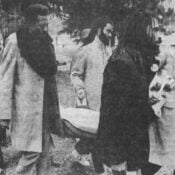The introduction of Katharine Brush’s semi-autobiography This Is on Me opens with the line: “This is a new kind of book.” One could say the same about every piece of her writing — whether it was books, short-stories, or articles — and how she was able to capture the cultural shift occurring in America during the 1920s.
Brush — a columnist, short-story writer, and novelist — was one of the most widely read and highest paid female fiction writers of the 1920s and 1930s. Critics praised her writing, especially her two bestselling novels Young Man of Manhattan and Red-Headed Woman, both of which were adapted into successful pre-Code movies — and both of which appeared in The Saturday Evening Post.
Born on August 15, 1902, in Middletown, Connecticut, to educator Charles S. Ingham and Clara Ingham, Brush’s passion for writing and academics bloomed early. She grew up in South Byfield, Massachusetts, where she attended Dummer Academy, the boys’ school where her father was the headmaster. Soon after graduating from Centenary Collegiate Institute at just 16, she started working as a movie columnist for the Boston Evening Traveller. Despite obstacles for female sportswriters in the Jazz Age, Brush wrote about boxing and college football, and covered the World Series for several newspapers in Ohio in 1925 and 1926. Her work also appeared in publications such as College Humor, Cosmopolitan, Harper’s Magazine, The New Yorker, and, of course, The Saturday Evening Post.
In 1923, Brush began writing fiction, exploring glamour, ambition, and the price of chasing the American Dream in the Roaring Twenties. She reached the bestseller lists in 1930 with her fourth novel, Young Man of Manhattan. It follows columnist Ann Vaughn and how her growing success stains her relationship with her husband, an ambitious sportswriter. In the same year, the book was adapted into a musical comedy starring Claudette Colbert as Vaughn, Norman Foster as the husband, and Ginger Rogers as socialite Puff Randolph. The movie had a huge influence in the 1930s; Rogers’s line “cigarette me, big boy!” became a popular catchphrase during the Great Depression.
Scene from Young Man of Manhattan (Uploaded to YouTube by Pre-Code Film Clips, and More)
Her next novel, Red-Headed Woman, which was also first published as a seven-part series in The Saturday Evening Post in 1931, became her most popular novel to date. It follows Lillian “Lil” Andrews, a secretary living in Redwood, Ohio, who is willing to do anything to climb the social ladder — even break up her boss’s marriage.
Red-Headed Woman was also adapted into a movie of the same name. Initially, F. Scott Fitzgerald was hired to write the screenplay, but his version was deemed “too serious,” and the director ultimately replaced him with Anita Loos, the author of Gentlemen Prefer Blondes, who adapted the book in a more comedic way. When it was first released, the movie was censored by multiple states and even banned from the U.K. for being “problematic” and “immoral,” but that did not limit its success. Today, the romantic comedy is considered a prime example of a pre-Code movie — films made in Hollywood between 1929 and 1934, before the strict reinforcement of the Motion Picture Production Code — for its bold depiction of female sexuality, adultery, and social ambition free of restriction by the film industry. The movie also launched Jean Harlow, who portrayed Lil, into stardom.
Scene from Red-Headed Woman (Uploaded to YouTube by eddies Movies77)
Brush’s writing was not only praised by general readers, but also highly critically acclaimed, with many critics comparing her prose to that of F. Scott Fitzgerald because of how both captured the atmosphere of the Roaring Twenties and the American Dream in their works. One critic in the early ’30s wrote that “the short stories and novels of Katharine Brush were probably the most eloquent expressions of the boom era — that period of raccoon coats [and] night clubs.” The December 31, 1932, issue of the Post notes that Brush’s novelette Everybody Happy “gives a vivid picture of the social life of the country-club set of a small town … the stories of these three [main characters], and a group of minor characters, are skillfully woven into one vivid narrative.” The magazine Look stated in 1940 that Brush’s work was “sophisticated, tricky, witty, full of Yankee reserve, as American as the Charleston.”
Brush passed away at the age of 49 after a long illness in New York. At her passing, she had been working on a novel called Lover Come Back, which remains incomplete and has never been published. Brush’s only son, Thomas, donated money in her memory to the Loomis Chaffee School of Windsor, Connecticut, where a library was named after her. On the second floor hangs a large portrait of Katharine Brush, a constant reminder of her legacy and outstanding career as a writer and columnist.
Become a Saturday Evening Post member and enjoy unlimited access. Subscribe now





Comments
Any idea where you can watch “Red Headed Woman” in its entirety? I think I’d like that movie. It’s too bad Brush died at such an early age as did Fitzgerald and so ironic as well. Their literature personified that time in American culture.
Great article, Selina. I wasn’t aware of Katharine Brush previously, and of her remarkable career. She was definitely born at the right time, and got into the right field to capture the highs (and lows) of the ’20s, impressing powerful people in the film industry to create films based on her works.
I appreciate the film links here. The ‘Cigarette me’ scene featuring Ginger Rogers is wonderful. Always a favorite of mine, her versatility as an actress in both comedy and drama unfortunately do get overlooked because of her legendary dancing scenes with Fred Astaire. The scene from ‘Red Headed Woman’ with Jean Harlow is great too.
Your link on the pre-code films are also appreciated. I can see why these two, and many others I’ve seen here on YouTube from the early ’30s fell into this category. Some were more overt than others visually, in topic or dialogue that went over a lot of people’s heads; then and now. Katharine’s beautiful Art Deco apartment is breathtaking. I’m sorry she didn’t live longer to enjoy it, and create who knows what else along the way, given the chance?